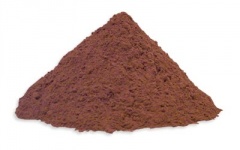Cocoa Powder
| Infobox on Cocoa Powder | |
|---|---|
| Example of Cocoa Powder |  |
| Facts | |
| Origin | - |
| Stowage factor (in m3/t) | - |
| Humidity / moisture | - |
| Ventilation | - |
| Risk factors | See text |
Cocoa Powder
Description
Cocoa solids are the low-fat component of chocolate. When sold as an end product, it may also be called cocoa powder, cocoa, and cacao. In contrast, the fatty component of chocolate is Cocoa Butter. Cocoa Butter is 50% to 57% of the weight of Cocoa Beans and gives chocolate its characteristic melting properties. Cocoa liquor is the melted combination of cocoa butter and cocoa solids. Cocoa solids are obtained by extraction from the cocoa bean.
Cocoa powder contains several minerals including Calcium, Copper, Magnesium, Phosphorus, Potassium, Sodium and Zinc. All of these minerals are found in greater quantities in cocoa powder than either cocoa butter or cocoa liquor. Cocoa solids also contain 230 mg of caffeine and 2057 mg of theobromine per 100 g, which are mostly absent from the other components of the cocoa bean.
Cocoa powder is rich in flavonoids, a type of phenolic. The amount of flavonoids depends on the amount of processing and manufacturing the cocoa powder undergoes, but cocoa powder can contain up to 10% its weight in flavonoids. Flavanols are one of six compounds further classified as flavonoids. Flavanols, which are also found in fruits and vegetables, are linked to certain health benefits linked to coronary heart disease and stroke. The topic of how flavanols benefit cardiovascular health is still under debate. It has been suggested that the flavanols may take part in mechanisms such as nitric oxide and antioxidant, anti-inflammatory, and antiplatelet effects. Benefiting these mechanisms may improve endothelial function, lipid levels, blood pressure and insulin resistance.
Cocoa Powder, sold as natural cocoa powder, is the end result from separating cocoa solids (low-fat components of chocolate) and Cocoa Butter (high-fat).
Cocoa powder gives an intense chocolate taste and is available in “Dutch-processed” (alkalized) or natural varieties. Natural cocoa powder is light brown, with a strong, pronounced chocolate flavor. It is slightly acidic, so it is best to use natural cocoa powder in recipes calling for baking soda. Alkalized cocoa powder is darker in color, less acidic, and has a milder chocolate taste. Alkalized cocoa powder is recommended for recipes that call for baking powder.
Cocoa powder is formed from the cocoa mass. Presses are used to remove some of the fat and leave a solid material called cocoa press cake. These cakes are then crushed to form cocoa powder. The processing can be altered to produce cocoa powders of different composition and with different levels of fat.
An indication of the composition of cocoa powder is as follows, but it must be remembered that this will be different depending on the roasting, alkalisation and pressing processes undertaken:
| Moisture % | 3.0 |
| Cocoa butter | 11.0 |
| pH (10% suspension) | 5.7 |
| Ash % | 5.5 |
| Water soluble ash % | 2.2 |
| Alkalinity of water soluble ash as K2O in original cocoa % | 0.8 |
| Phosphate (as P2O5)% | 1.9 |
| Chloride (as NaCl) % | 0.04 |
| Ash insoluble in 50% HCl | 0.08 |
| Shell % (calculated to unalkalised nib) | 1.4 |
| Total nitrogen | 4.3 |
| Nitrogen (corrected for alkaloids) % | 3.4 |
| Protein | |
| Nitrogen corrected for alkaloids x 6.25% | 21.2 |
| Theobromine % | 2.8 |
Note: According to FDA guidelines, cocoa powder and cacao powder are simply different terms for the same powder, and are nearly interchangeable; however, "cacao powder" specifically refers to raw, unsweetened powder. "Cocoa powder," on the other hand, may still have a very small amount of cocoa butter present to enhance the flavor subtly."
Shipment / Storage / Risk factors
Powder from ground cocoa press cake. Shipped in paper sacks. When damaged by fire will continue to smoulder for considerable time, even after complete soaking of sacks by water.
Obviously to be stowed in a dry, clean space, free from foreign odours.











